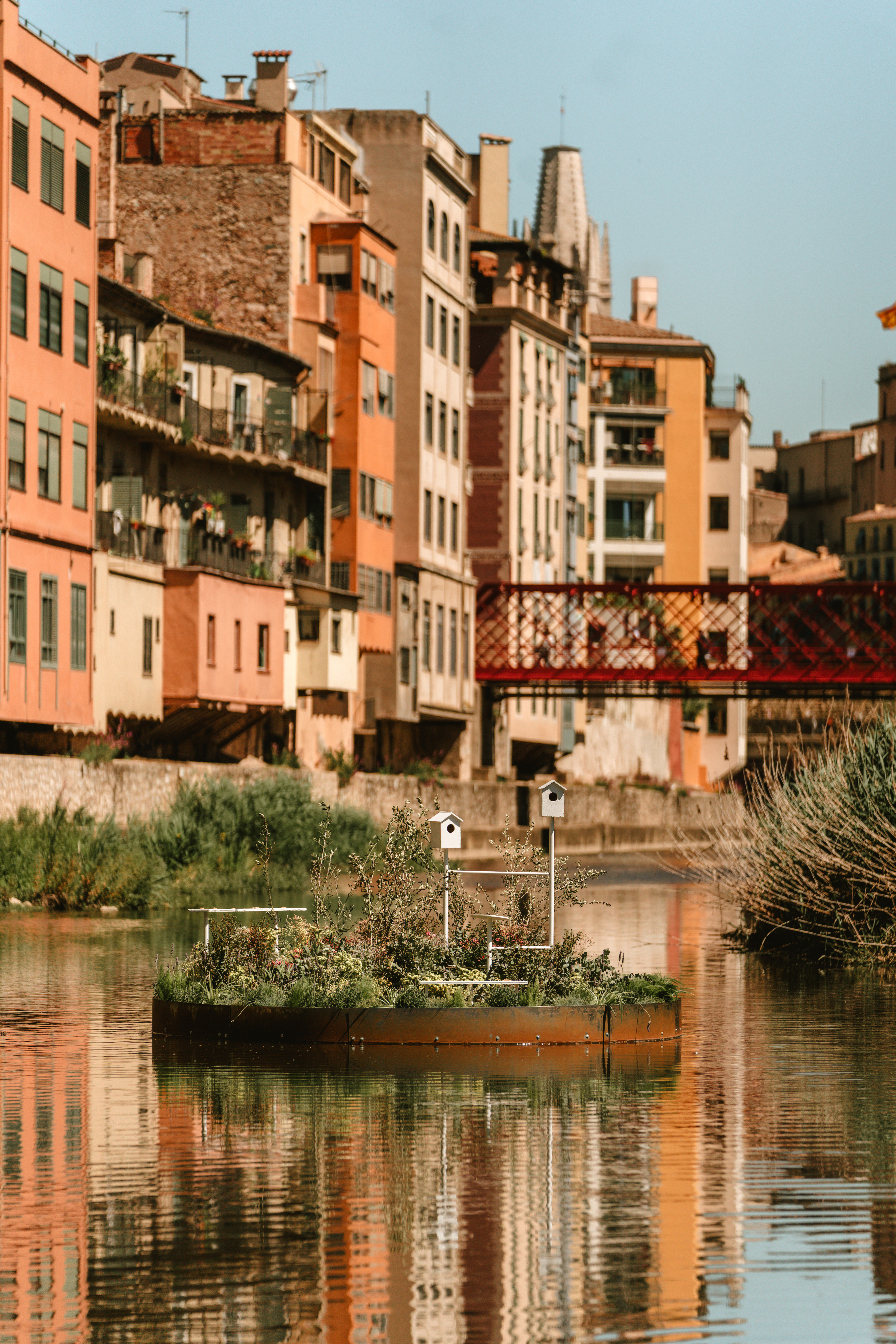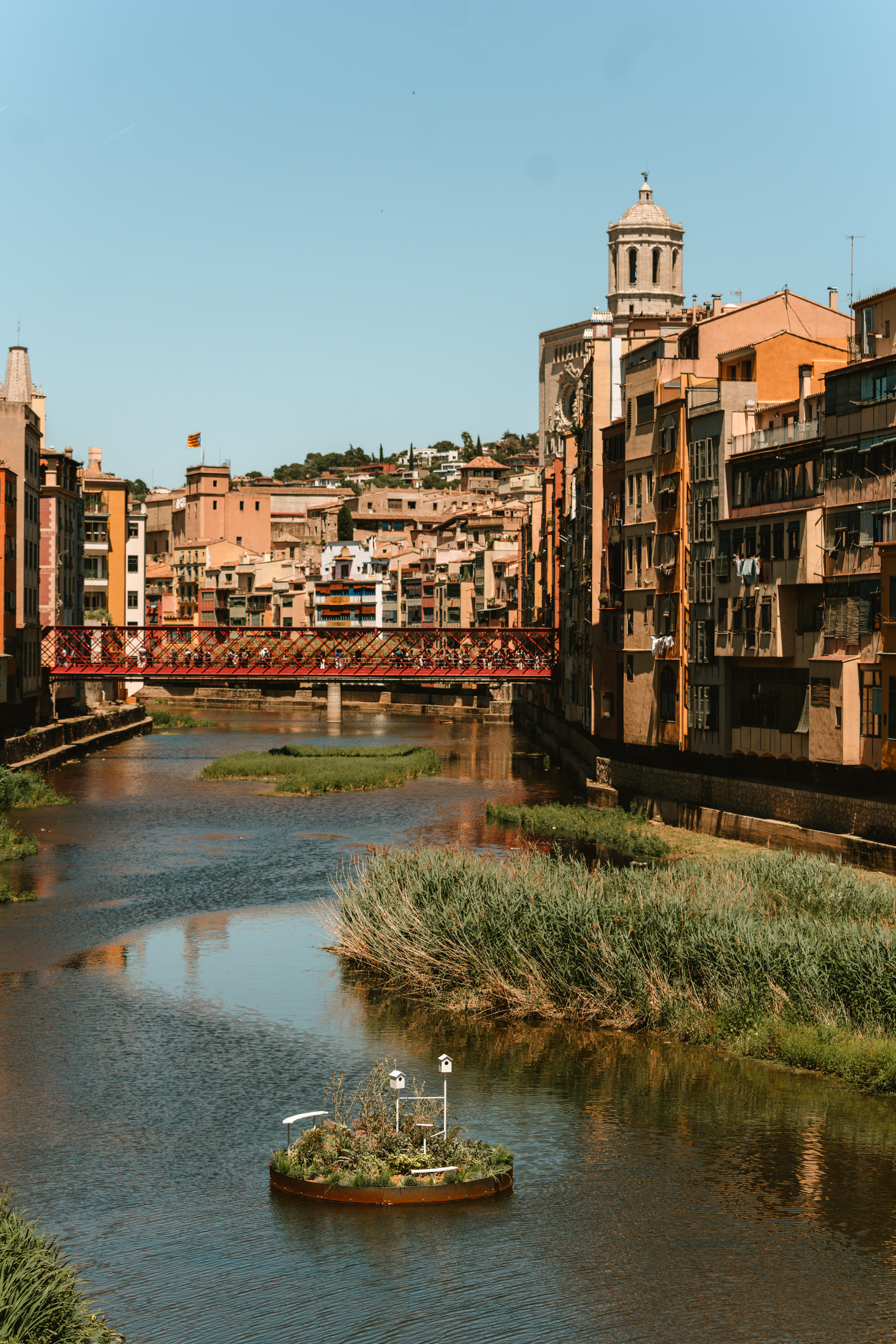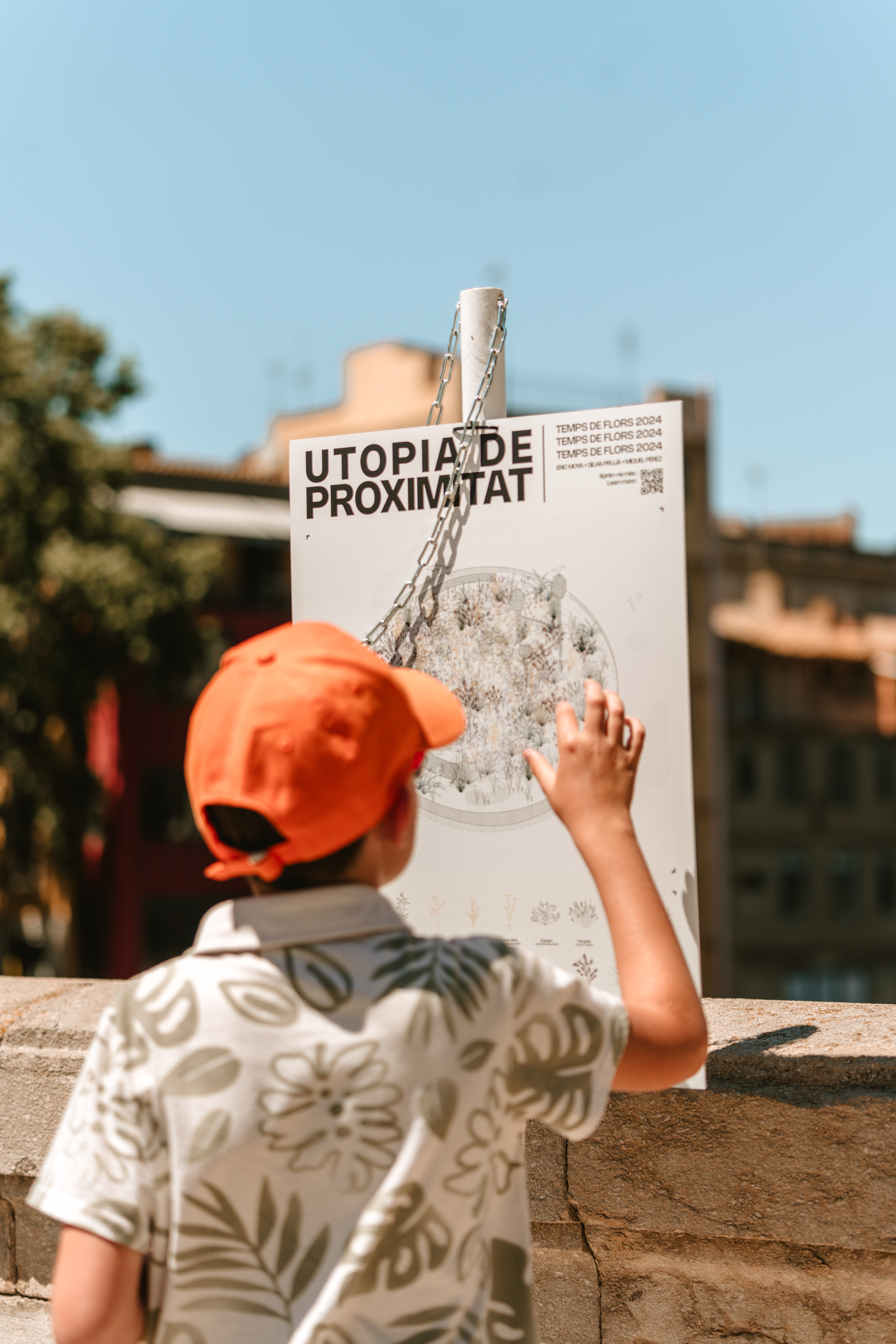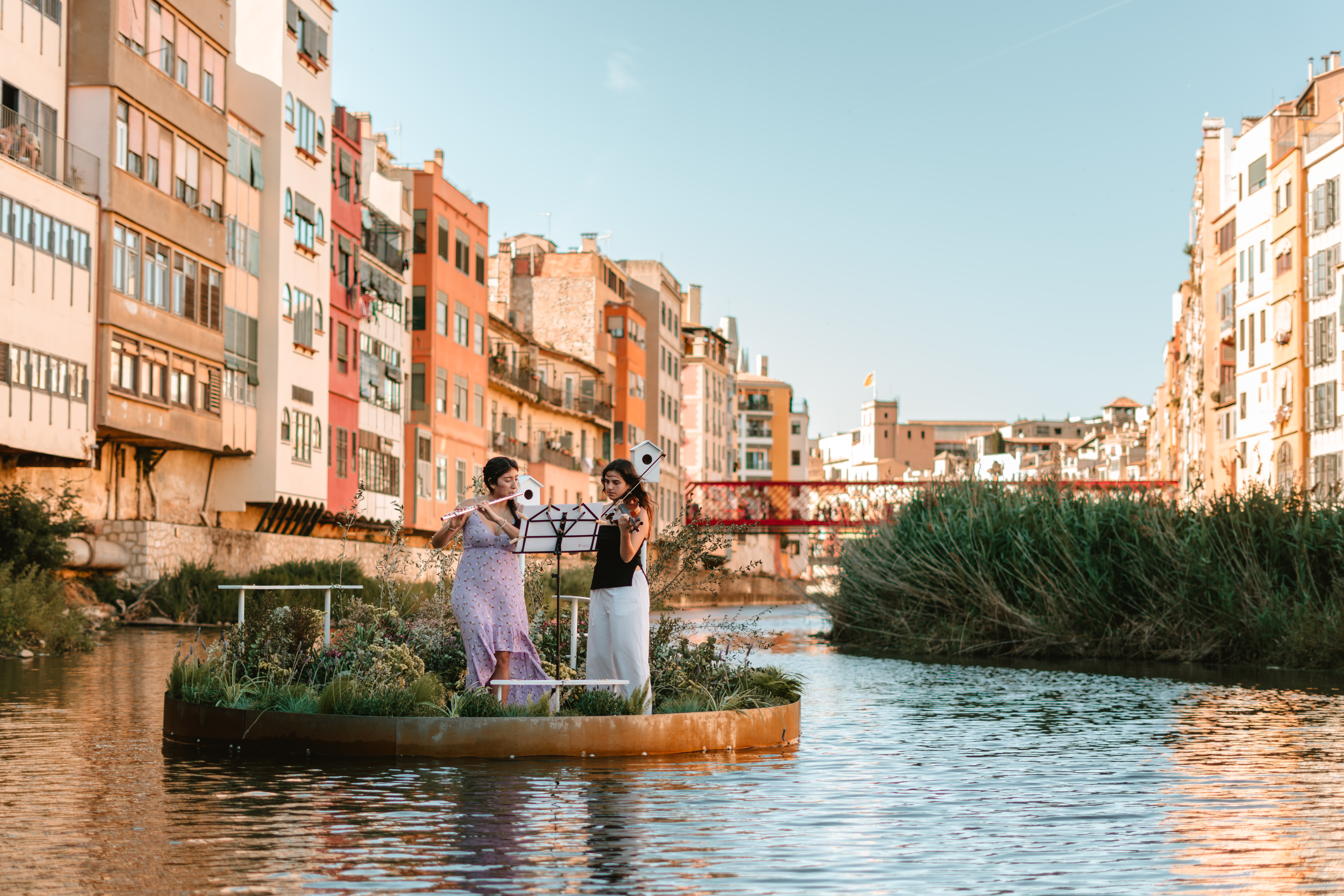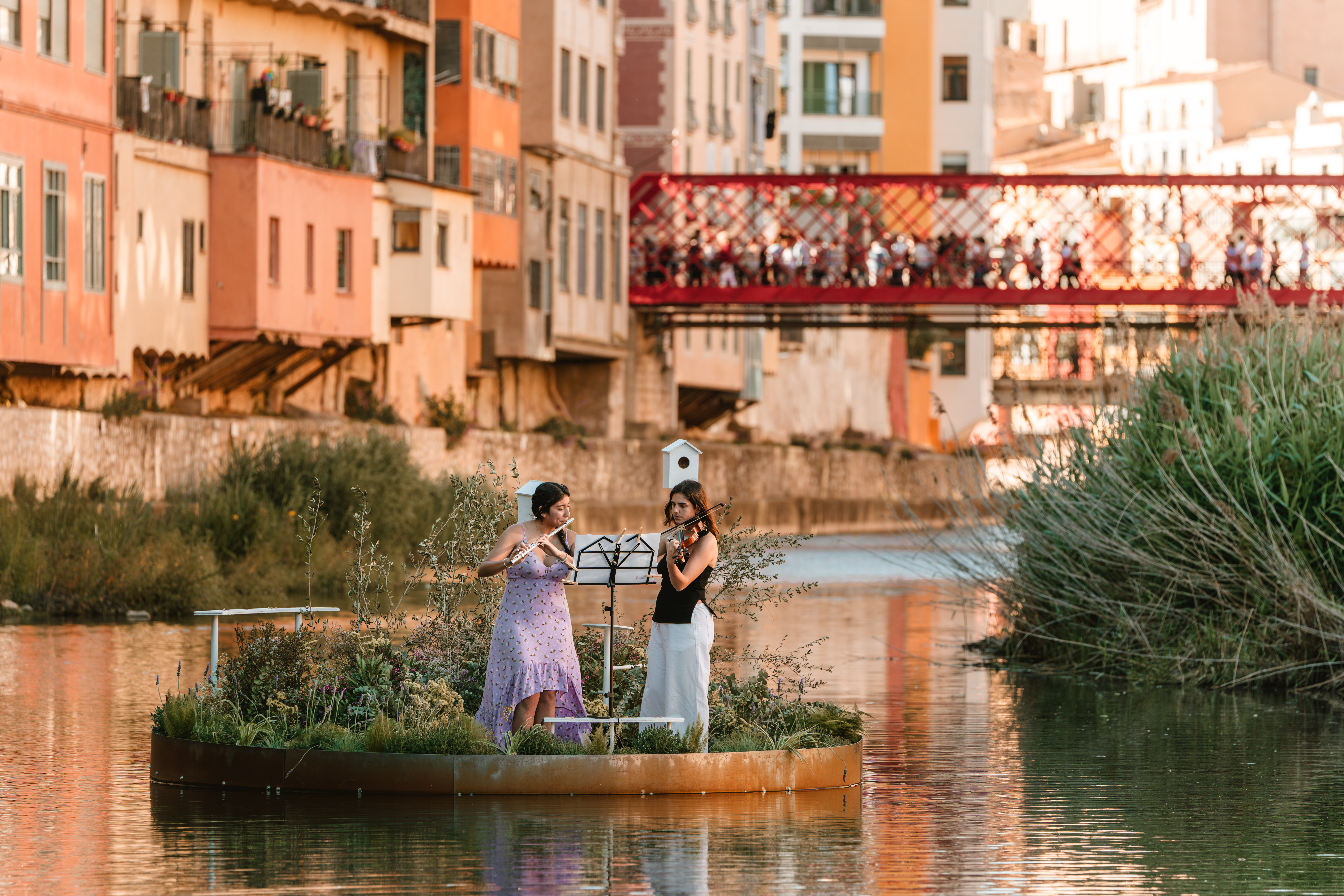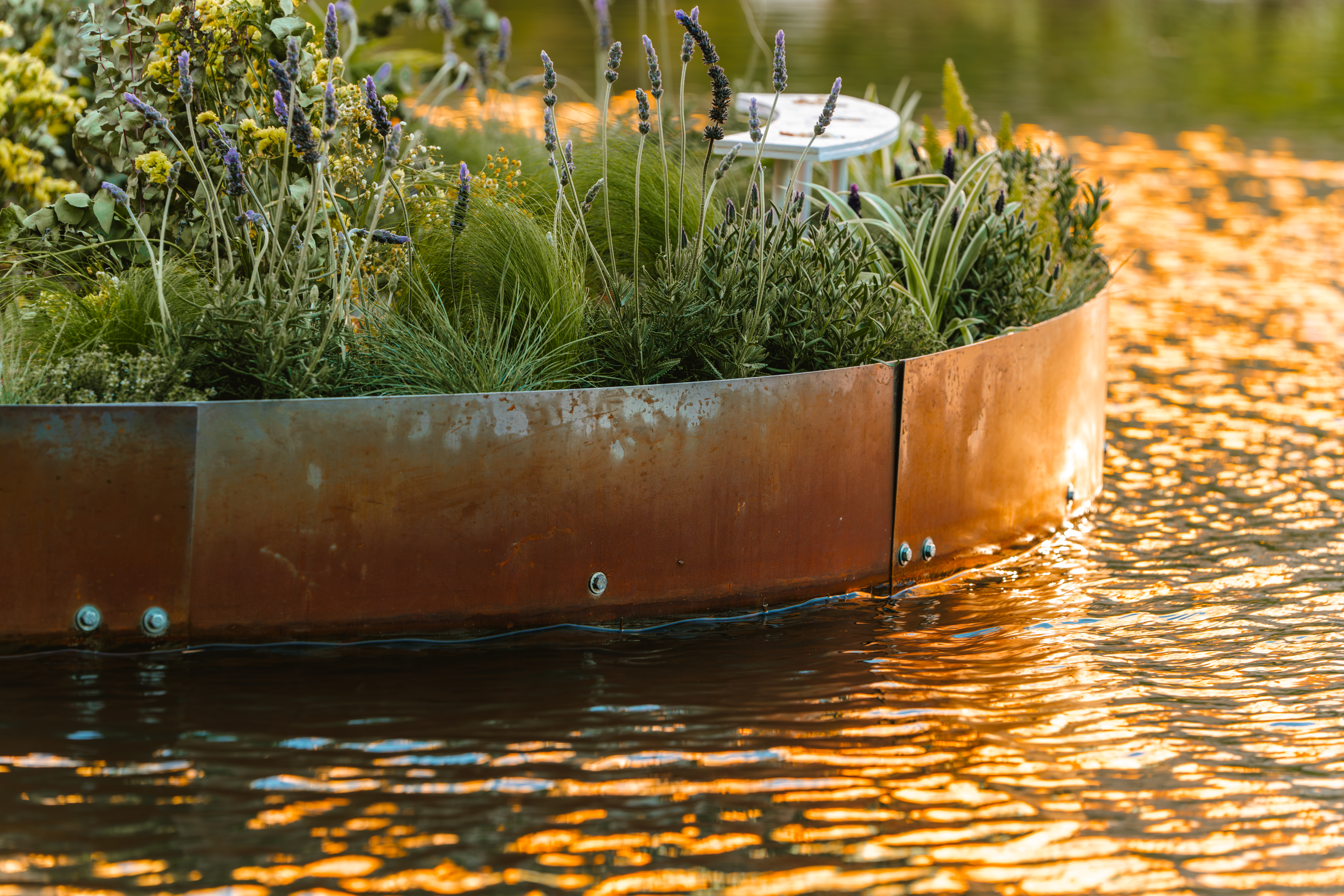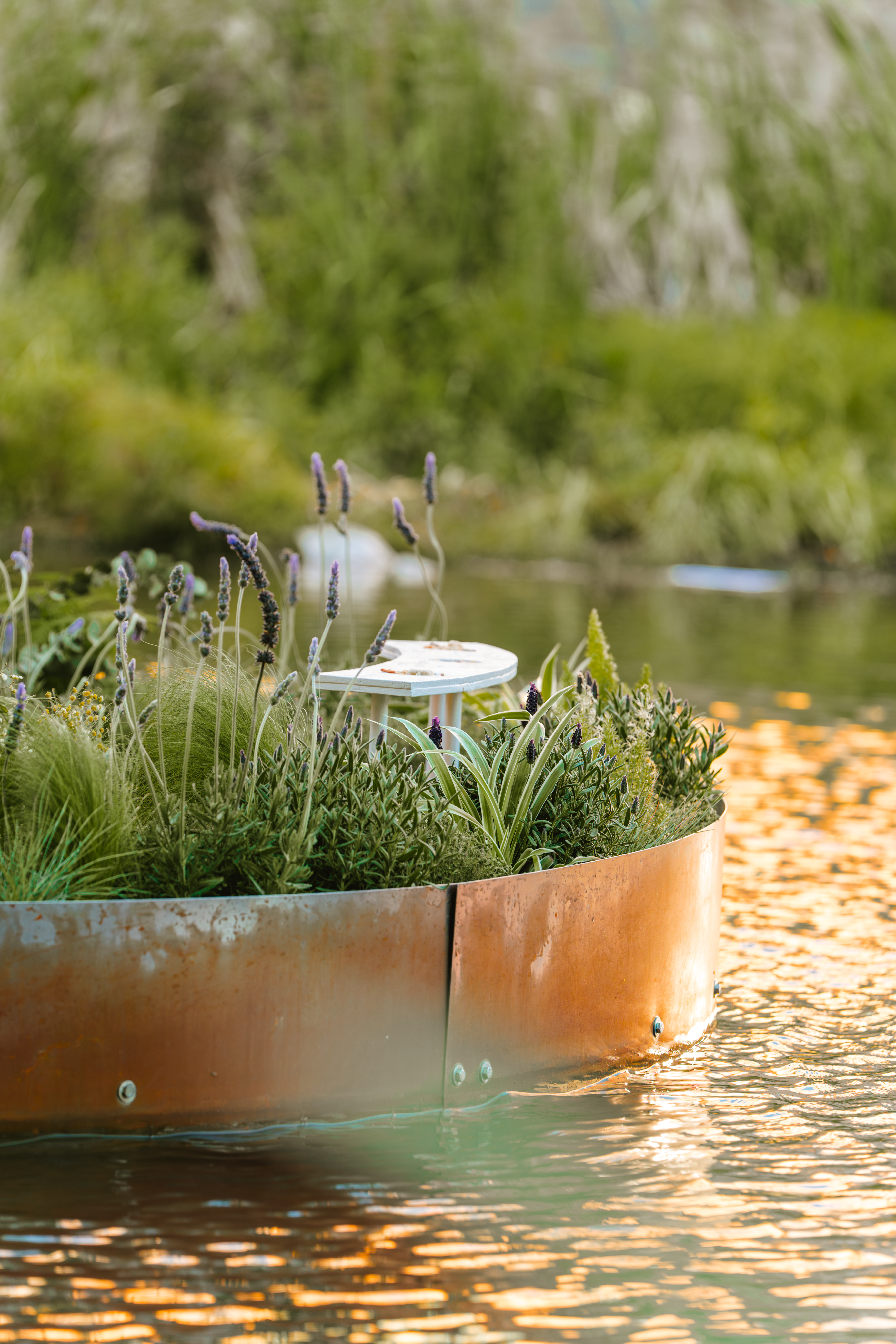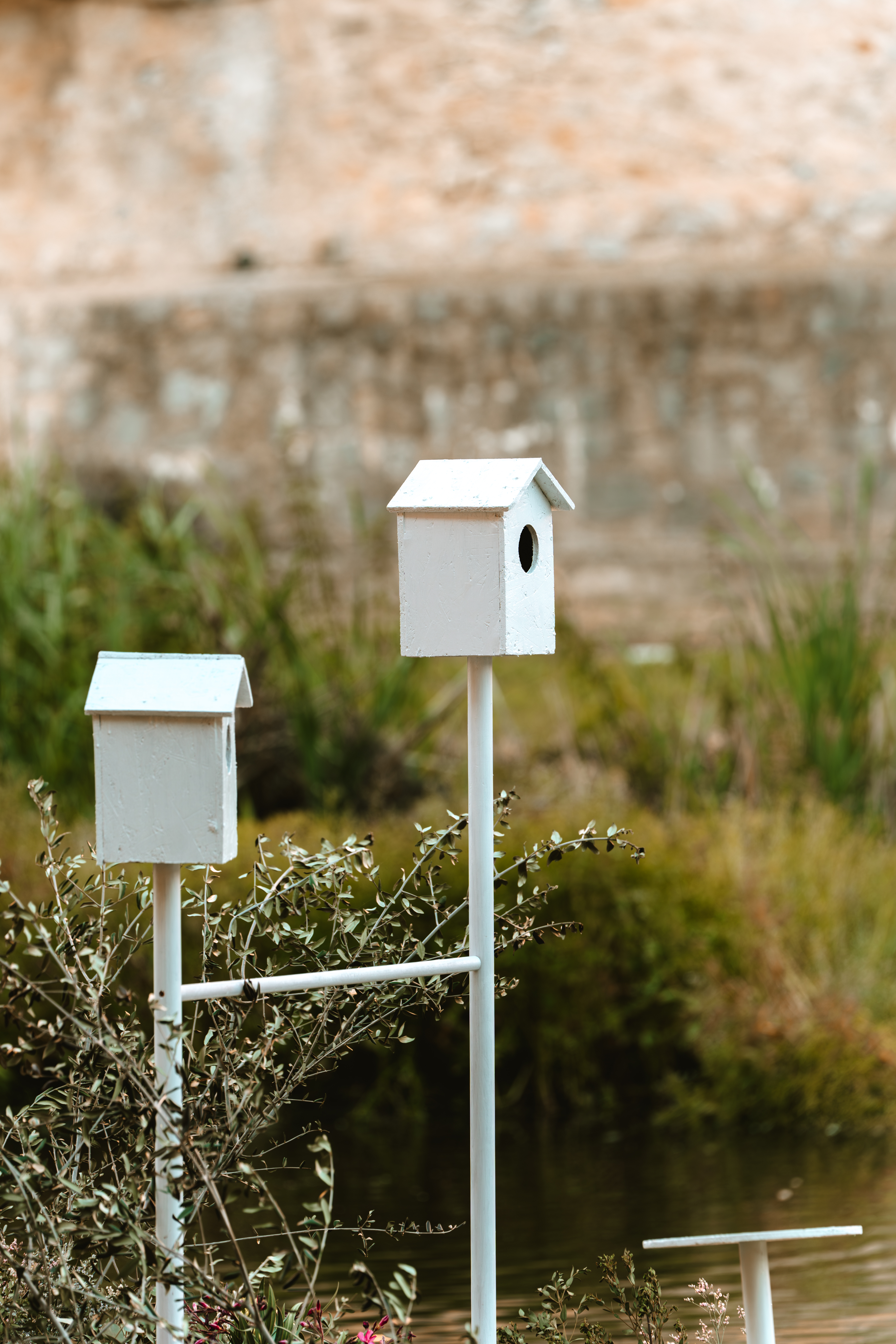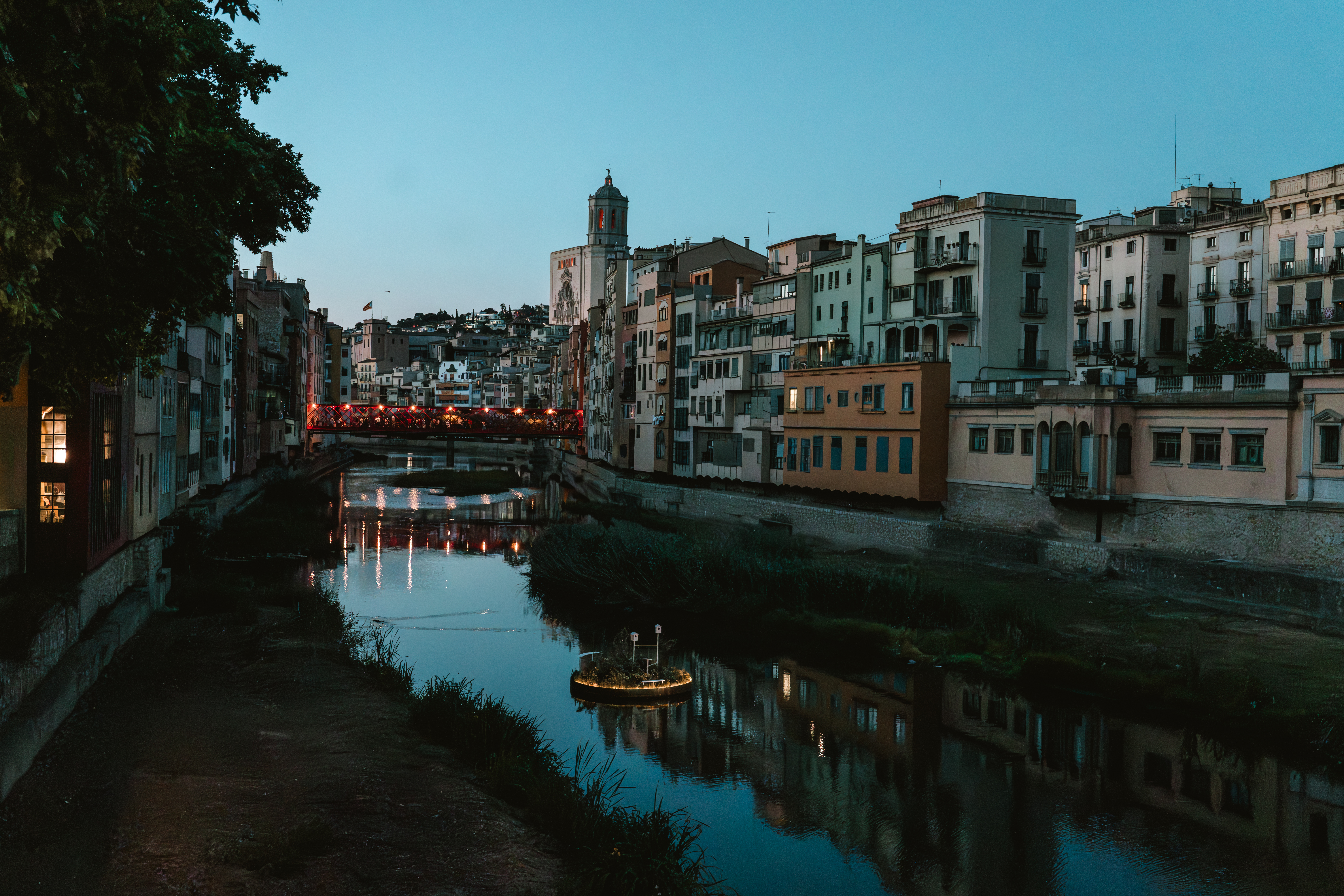Reconnecting with nature
Utopia of Proximity
Utopia of Proximity: Regenerating local landscapes through sustainable architecture
Proximity Utopia is a floating installation that redefines the relationship between city and nature. Placed on the Onyar River, it becomes an island of biodiversity, blurring the boundaries between architecture and ecosystem. Using native species, it highlights nature as essential urban infrastructure. More than an aesthetic gesture, it envisions a future where cities embrace landscapes rather than displace them, inviting us to rethink how we inhabit our environment.
Spain
Local
Girona, Spain.
It addresses urban-rural linkages
It refers to other types of transformations (soft investment)
Yes
2024-05-10
No
No
No
As an individual partnership with other persons/organisation(s)
"Proximity Utopia" is a floating ephemeral installation that redefines the relationship between cities and nature. Situated on the Onyar River, it creates a biodiversity island that fosters dialogue between architecture and ecosystems, highlighting nature as essential urban infrastructure. By integrating native vegetation into the urban fabric, it demonstrates how cities can embrace natural ecosystems rather than displacing them. Targeted at local communities, urban planners, and policymakers, the project encourages a shift towards nature-inclusive urban planning.
The installation serves as a prototype to explore new ways of integrating biodiversity into public spaces. Its objectives are to restore ecological balance in urban environments, raise awareness about biodiversity and water ecosystems, and create a space where nature and urban life blend harmoniously. The project has already achieved key outcomes, including the creation of a tangible prototype, public engagement through an immersive experience, and contribution to discussions on urban resilience and climate adaptation.
By aligning with the New European Bauhaus values, "Proximity Utopia" promotes sustainability through biodiversity restoration, inclusivity by reclaiming nature as a shared public space, and beauty by enhancing the sensory experience of the city. In the long term, it encourages greener, more resilient cities where nature is fully integrated.
The Onyar River, like many urban water bodies, faces biodiversity loss, pollution, and disconnection from the urban environment. "Proximity Utopia" addresses these challenges by restoring riverbank ecosystems with native species, engaging communities in ecological preservation, and proposing a scalable model for other cities. The project envisions cities as spaces where nature and urban life coexist, fostering healthier and more resilient environments for future generations.
The installation serves as a prototype to explore new ways of integrating biodiversity into public spaces. Its objectives are to restore ecological balance in urban environments, raise awareness about biodiversity and water ecosystems, and create a space where nature and urban life blend harmoniously. The project has already achieved key outcomes, including the creation of a tangible prototype, public engagement through an immersive experience, and contribution to discussions on urban resilience and climate adaptation.
By aligning with the New European Bauhaus values, "Proximity Utopia" promotes sustainability through biodiversity restoration, inclusivity by reclaiming nature as a shared public space, and beauty by enhancing the sensory experience of the city. In the long term, it encourages greener, more resilient cities where nature is fully integrated.
The Onyar River, like many urban water bodies, faces biodiversity loss, pollution, and disconnection from the urban environment. "Proximity Utopia" addresses these challenges by restoring riverbank ecosystems with native species, engaging communities in ecological preservation, and proposing a scalable model for other cities. The project envisions cities as spaces where nature and urban life coexist, fostering healthier and more resilient environments for future generations.
Biodiversity
Urban Resilience
Nature-Based Solutions
Public Space
Ecological Awareness
"Proximity Utopia" exemplifies the values of the New European Bauhaus by merging sustainability, inclusion, and aesthetics in an innovative urban intervention. The project reimagines the relationship between cities and nature, demonstrating that ecological restoration can be both functional and beautiful while fostering social engagement.
The installation enhances biodiversity and urban resilience by introducing native vegetation into the Onyar River, creating a self-sustaining ecosystem that improves water quality, supports local fauna, and mitigates the urban heat island effect. By using biodegradable and locally sourced materials, it minimizes its environmental footprint and aligns with circular design principles. As a nature-based solution, it shows how low-impact, temporary interventions can lead to long-term ecological benefits.
Beyond its environmental impact, "Proximity Utopia" promotes social inclusion by transforming a neglected waterway into an accessible and collective space. The project fosters public engagement and awareness of urban ecology, encouraging citizens, local organizations, and policymakers to see nature as a shared resource. Developed through a participatory process, it brings together architects, ecologists, and the local community to co-create a vision for a more inclusive and resilient city.
The project is not only a sustainability-driven solution but also an immersive experience that enhances the city's aesthetic and cultural value. By seamlessly integrating natural and built elements, it invites contemplation and offers a new perspective on the urban landscape. "Proximity Utopia" demonstrates that sustainable solutions can be beautiful, socially inclusive, and environmentally regenerative, providing an exemplary, scalable model for future cities.
The installation enhances biodiversity and urban resilience by introducing native vegetation into the Onyar River, creating a self-sustaining ecosystem that improves water quality, supports local fauna, and mitigates the urban heat island effect. By using biodegradable and locally sourced materials, it minimizes its environmental footprint and aligns with circular design principles. As a nature-based solution, it shows how low-impact, temporary interventions can lead to long-term ecological benefits.
Beyond its environmental impact, "Proximity Utopia" promotes social inclusion by transforming a neglected waterway into an accessible and collective space. The project fosters public engagement and awareness of urban ecology, encouraging citizens, local organizations, and policymakers to see nature as a shared resource. Developed through a participatory process, it brings together architects, ecologists, and the local community to co-create a vision for a more inclusive and resilient city.
The project is not only a sustainability-driven solution but also an immersive experience that enhances the city's aesthetic and cultural value. By seamlessly integrating natural and built elements, it invites contemplation and offers a new perspective on the urban landscape. "Proximity Utopia" demonstrates that sustainable solutions can be beautiful, socially inclusive, and environmentally regenerative, providing an exemplary, scalable model for future cities.
"Proximity Utopia" is designed to create an immersive, sensorial experience that blends the urban environment with the natural world, offering a new way to interact with the city. The project transforms the Onyar River into a contemplative and inclusive public space, where aesthetics and nature work together to evoke emotion and reflection. Through its integration of native vegetation, the installation serves as a living, dynamic piece of art that constantly evolves with the seasons, allowing visitors to experience the passage of time in an urban context.
The design prioritizes visual harmony and sensory engagement, with carefully selected plant species and natural materials that enhance the connection to nature. The floating island creates a striking visual contrast to the surrounding cityscape while seamlessly blending with the river’s natural features. This balance between built and natural environments enhances the quality of experience, offering moments of peace and connection for visitors, encouraging them to reflect on their relationship with the environment.
In terms of cultural benefits, the project invites dialogue on the future of cities and their relationship with nature. It fosters a sense of belonging and shared ownership, as the public is encouraged to engage with and care for this ecological space. The integration of art, architecture, and ecology fosters a deepened cultural appreciation for sustainable design and urban biodiversity.
As an exemplary project, "Proximity Utopia" shows how design can create environments that are not only functional but also beautiful, transformative, and meaningful. It demonstrates that sustainable interventions can elevate the urban experience, creating spaces that people connect with on a personal, emotional, and cultural level, while enhancing the urban landscape and fostering public consciousness.
The design prioritizes visual harmony and sensory engagement, with carefully selected plant species and natural materials that enhance the connection to nature. The floating island creates a striking visual contrast to the surrounding cityscape while seamlessly blending with the river’s natural features. This balance between built and natural environments enhances the quality of experience, offering moments of peace and connection for visitors, encouraging them to reflect on their relationship with the environment.
In terms of cultural benefits, the project invites dialogue on the future of cities and their relationship with nature. It fosters a sense of belonging and shared ownership, as the public is encouraged to engage with and care for this ecological space. The integration of art, architecture, and ecology fosters a deepened cultural appreciation for sustainable design and urban biodiversity.
As an exemplary project, "Proximity Utopia" shows how design can create environments that are not only functional but also beautiful, transformative, and meaningful. It demonstrates that sustainable interventions can elevate the urban experience, creating spaces that people connect with on a personal, emotional, and cultural level, while enhancing the urban landscape and fostering public consciousness.
The project aims to foster social and environmental inclusion by transforming an overlooked urban space into a publicly accessible and ecologically restorative environment for the entire community. By creating a floating biodiversity island on the Onyar River, it promotes equal access to nature, where everyone, regardless of background or social status, can enjoy a shared natural setting.
The design ensures accessibility for all, inviting citizens, visitors, and local groups to engage with the environment. This creates a space for social interaction and community connection, where people can immerse themselves in nature and actively participate in reshaping their urban surroundings.
The project also follows a participatory approach, involving local stakeholders in both the design and upkeep of the space. This methodology fosters empowerment and shared responsibility, as citizens play an active role in the creation and maintenance of the floating island, resulting in a strong sense of belonging and social cohesion.
"Proximity Utopia" addresses economic accessibility by creating a low-cost, low-impact public space. Its sustainable, affordable solution can be replicated in other urban contexts, offering a model that integrates biodiversity and community engagement as essential components of resilient urban life.
As an exemplary project, it demonstrates how inclusive urban design and active community participation can lead to a socially equitable public space, respecting diversity and empowering communities through public space.
The design ensures accessibility for all, inviting citizens, visitors, and local groups to engage with the environment. This creates a space for social interaction and community connection, where people can immerse themselves in nature and actively participate in reshaping their urban surroundings.
The project also follows a participatory approach, involving local stakeholders in both the design and upkeep of the space. This methodology fosters empowerment and shared responsibility, as citizens play an active role in the creation and maintenance of the floating island, resulting in a strong sense of belonging and social cohesion.
"Proximity Utopia" addresses economic accessibility by creating a low-cost, low-impact public space. Its sustainable, affordable solution can be replicated in other urban contexts, offering a model that integrates biodiversity and community engagement as essential components of resilient urban life.
As an exemplary project, it demonstrates how inclusive urban design and active community participation can lead to a socially equitable public space, respecting diversity and empowering communities through public space.
The relationship with citizens in "Proximity Utopia" focuses on visual engagement and raising awareness about nature and biodiversity in the urban environment. The installation acts as both an educational and participatory tool, inviting the community to reflect on the role of nature within their city and the importance of preserving local ecosystems.
Through interactive displays and educational materials, the project encourages visitors to engage with the floating biodiversity island and learn about the native species it hosts. This creates a unique opportunity for the public to deepen their understanding of local biodiversity and the challenges of maintaining ecological balance in an urban context.
While the project is not physically participatory in the traditional sense, it offers an accessible, open platform for the community to actively engage with sustainability efforts. By interacting with the installation, citizens are invited to think about how their actions can contribute to the well-being of the environment, fostering a deeper connection with nature.
The impact of this involvement is primarily through visual and educational awareness, leading to greater environmental consciousness within the local community. The project not only encourages dialogue about sustainability and ecological preservation but also positions nature as an essential, visible part of urban life, making it more relatable and meaningful to citizens.
Through interactive displays and educational materials, the project encourages visitors to engage with the floating biodiversity island and learn about the native species it hosts. This creates a unique opportunity for the public to deepen their understanding of local biodiversity and the challenges of maintaining ecological balance in an urban context.
While the project is not physically participatory in the traditional sense, it offers an accessible, open platform for the community to actively engage with sustainability efforts. By interacting with the installation, citizens are invited to think about how their actions can contribute to the well-being of the environment, fostering a deeper connection with nature.
The impact of this involvement is primarily through visual and educational awareness, leading to greater environmental consciousness within the local community. The project not only encourages dialogue about sustainability and ecological preservation but also positions nature as an essential, visible part of urban life, making it more relatable and meaningful to citizens.
The "Proximity Utopia" project was conceived within the framework of Girona Temps de Flors, a competition focused on showcasing ephemeral installations that highlight the flora and vegetation of the city. This initiative provided an ideal platform to bring attention to the local biodiversity and demonstrate the potential of integrating nature within urban spaces.
Our team, composed of Km13 and Miquel Pérez, architects and landscape designers, has always had a clear intention: to highlight the biodiversity of the region through design. As part of this vision, we proposed "Proximity Utopia" as a representation of how nature can be seamlessly integrated into the built environment. The installation is intended to inspire future applications in other locations and scenarios, extending the idea to other cities or regions facing similar ecological challenges.
At the local level, we collaborated closely with the Girona municipal team to align the installation with the objectives of the event, ensuring it resonated with the city's identity and commitment to sustainability. On a regional level, our project has sparked interest in the broader Catalonia area, opening up conversations on how nature can be reconnected with urban spaces. On a European scale, the project is seen as an example of how local biodiversity can be integrated into city landscapes, which could inspire similar initiatives across Europe.
The added value of this multi-level engagement lies in its ability to showcase how local biodiversity can become a part of the urban fabric, creating awareness and laying the groundwork for future implementation in diverse contexts.
Our team, composed of Km13 and Miquel Pérez, architects and landscape designers, has always had a clear intention: to highlight the biodiversity of the region through design. As part of this vision, we proposed "Proximity Utopia" as a representation of how nature can be seamlessly integrated into the built environment. The installation is intended to inspire future applications in other locations and scenarios, extending the idea to other cities or regions facing similar ecological challenges.
At the local level, we collaborated closely with the Girona municipal team to align the installation with the objectives of the event, ensuring it resonated with the city's identity and commitment to sustainability. On a regional level, our project has sparked interest in the broader Catalonia area, opening up conversations on how nature can be reconnected with urban spaces. On a European scale, the project is seen as an example of how local biodiversity can be integrated into city landscapes, which could inspire similar initiatives across Europe.
The added value of this multi-level engagement lies in its ability to showcase how local biodiversity can become a part of the urban fabric, creating awareness and laying the groundwork for future implementation in diverse contexts.
The design and implementation of "Proximity Utopia" involved a range of disciplines, each contributing to its success. The project integrated architecture, landscape design, sustainability, biodiversity, and public art, creating a comprehensive approach to merging nature with urban space.
The architects and landscape designers (from Km13 and Miquel Pérez) were responsible for shaping the installation, ensuring it was both visually compelling and functionally integrated into the environment. Their expertise in spatial design helped bring the vision to life. Biodiversity specialists and ecologists played a crucial role in advising on the selection of native plants and assessing the ecological impact, ensuring the installation promoted local biodiversity.
The project also embraced principles of sustainable design, with the use of native species and eco-friendly practices, contributing positively to the environment. Artistic and cultural input further enriched the project, turning it into a form of public art that invited visitors to interact with the installation, fostering awareness and connection with nature.
The collaboration between these diverse fields allowed the creation of an installation that is not only environmentally sustainable but also socially engaging. It became a tool for public education, encouraging people to reflect on the relationship between urban life and the natural world. The added value of this process was the ability to create a project that balances aesthetic appeal, environmental responsibility, and community involvement.
The architects and landscape designers (from Km13 and Miquel Pérez) were responsible for shaping the installation, ensuring it was both visually compelling and functionally integrated into the environment. Their expertise in spatial design helped bring the vision to life. Biodiversity specialists and ecologists played a crucial role in advising on the selection of native plants and assessing the ecological impact, ensuring the installation promoted local biodiversity.
The project also embraced principles of sustainable design, with the use of native species and eco-friendly practices, contributing positively to the environment. Artistic and cultural input further enriched the project, turning it into a form of public art that invited visitors to interact with the installation, fostering awareness and connection with nature.
The collaboration between these diverse fields allowed the creation of an installation that is not only environmentally sustainable but also socially engaging. It became a tool for public education, encouraging people to reflect on the relationship between urban life and the natural world. The added value of this process was the ability to create a project that balances aesthetic appeal, environmental responsibility, and community involvement.
"Proximity Utopia" stands out for its innovative approach to blending nature and urban spaces. Unlike traditional urban installations or green projects, this initiative goes beyond beautification or simple environmentalism. It is an ephemeral installation that not only emphasizes biodiversity, but also introduces a didactic element to raise awareness among the public about the importance of local ecosystems.
The project challenges the common practice of treating nature and architecture as separate entities by showcasing how integrating biodiversity into the urban fabric is essential for creating resilient, sustainable cities. By using native species and eco-friendly techniques, it proposes an alternative to conventional landscaping, which often prioritizes ornamental or non-native plants. This focus on local flora reflects a shift towards circularity and environmental responsibility.
Furthermore, unlike typical urban interventions, "Proximity Utopia" aims to engage the public in a participatory manner, allowing citizens to connect with and reflect on their local environment. This is a departure from mainstream urban art, which often lacks the interactive, educational component that empowers individuals to act on the knowledge they gain.
In its fusion of architecture, sustainability, and community engagement, the project proposes a new model for urban development—one that actively incorporates biodiversity, participation, and sustainability into the design and implementation of public spaces.
The project challenges the common practice of treating nature and architecture as separate entities by showcasing how integrating biodiversity into the urban fabric is essential for creating resilient, sustainable cities. By using native species and eco-friendly techniques, it proposes an alternative to conventional landscaping, which often prioritizes ornamental or non-native plants. This focus on local flora reflects a shift towards circularity and environmental responsibility.
Furthermore, unlike typical urban interventions, "Proximity Utopia" aims to engage the public in a participatory manner, allowing citizens to connect with and reflect on their local environment. This is a departure from mainstream urban art, which often lacks the interactive, educational component that empowers individuals to act on the knowledge they gain.
In its fusion of architecture, sustainability, and community engagement, the project proposes a new model for urban development—one that actively incorporates biodiversity, participation, and sustainability into the design and implementation of public spaces.
The methodology of Proximity Utopia is based on an interdisciplinary and participatory approach, combining sustainable design, landscape architecture, and public engagement. The project followed a step-by-step process, starting with contextual research and ending with public interaction and education.
The first phase involved contextual research and a biodiversity assessment, focused on understanding the local flora and ecosystem of Girona. This ensured the use of native species to promote biodiversity and ecological sustainability. Collaboration with ecologists helped guarantee the ecological integrity of the installation.
During the design development, we aimed to create a space that integrates nature into the urban environment, prioritizing simplicity, aesthetic appeal, and functionality. The design team, composed of Km13 (Sílvia Prujà & Èric Prujà) and Miquel Pérez, worked closely to ensure the installation was both visually striking and environmentally impactful.
In the construction phase, we used sustainable materials, minimizing the project’s environmental footprint. By incorporating circular design principles, we ensured materials could be reused or recycled, reinforcing the sustainability of the installation.
The final phase of the project focused on public engagement and education. The installation became a tool to raise awareness about biodiversity and urban sustainability, encouraging visitors to reflect on the relationship between nature and the city. Public participation was integral, allowing people to connect with their local environment in meaningful ways.
The first phase involved contextual research and a biodiversity assessment, focused on understanding the local flora and ecosystem of Girona. This ensured the use of native species to promote biodiversity and ecological sustainability. Collaboration with ecologists helped guarantee the ecological integrity of the installation.
During the design development, we aimed to create a space that integrates nature into the urban environment, prioritizing simplicity, aesthetic appeal, and functionality. The design team, composed of Km13 (Sílvia Prujà & Èric Prujà) and Miquel Pérez, worked closely to ensure the installation was both visually striking and environmentally impactful.
In the construction phase, we used sustainable materials, minimizing the project’s environmental footprint. By incorporating circular design principles, we ensured materials could be reused or recycled, reinforcing the sustainability of the installation.
The final phase of the project focused on public engagement and education. The installation became a tool to raise awareness about biodiversity and urban sustainability, encouraging visitors to reflect on the relationship between nature and the city. Public participation was integral, allowing people to connect with their local environment in meaningful ways.
One of the core strengths of Proximity Utopia lies in its high potential for transferability and replicability. The project offers a scalable and adaptable framework that can be applied in various urban and ecological contexts, encouraging a more integrated relationship between nature and the built environment.
A key transferable aspect is the methodological approach—the project demonstrates that nature and urban spaces do not have to be separate, but rather can coexist through interstitial spaces that blend architecture and ecology. This concept can be replicated in other cities, adapting to local climatic conditions and biodiversity, helping municipalities, designers, and communities rethink the urban-nature interface.
The educational dimension of the project is also highly replicable. The way Proximity Utopia engages the public in a visual, interactive, and didactic experience can serve as a model for other initiatives seeking to raise awareness about biodiversity, sustainability, and urban ecology. The approach of transforming public spaces into living exhibitions fosters a deeper connection between people and their environment, an idea that can be applied across different cultural and geographical contexts.
The concept of floating islands of vegetation is another highly adaptable feature. While initially designed for aquatic environments, this idea can also be applied to urban spaces, creating green islands within the city—pockets of biodiversity integrated into plazas, streets, or rooftops. These modular and flexible installations can be adjusted to different urban layouts, providing climatic benefits, aesthetic value, and ecological resilience.
By offering an adaptable blueprint, Proximity Utopia can inspire other urban projects to explore new ways of harmonizing built and natural environments, ensuring that cities evolve towards a more sustainable, inclusive, and ecologically conscious future.
A key transferable aspect is the methodological approach—the project demonstrates that nature and urban spaces do not have to be separate, but rather can coexist through interstitial spaces that blend architecture and ecology. This concept can be replicated in other cities, adapting to local climatic conditions and biodiversity, helping municipalities, designers, and communities rethink the urban-nature interface.
The educational dimension of the project is also highly replicable. The way Proximity Utopia engages the public in a visual, interactive, and didactic experience can serve as a model for other initiatives seeking to raise awareness about biodiversity, sustainability, and urban ecology. The approach of transforming public spaces into living exhibitions fosters a deeper connection between people and their environment, an idea that can be applied across different cultural and geographical contexts.
The concept of floating islands of vegetation is another highly adaptable feature. While initially designed for aquatic environments, this idea can also be applied to urban spaces, creating green islands within the city—pockets of biodiversity integrated into plazas, streets, or rooftops. These modular and flexible installations can be adjusted to different urban layouts, providing climatic benefits, aesthetic value, and ecological resilience.
By offering an adaptable blueprint, Proximity Utopia can inspire other urban projects to explore new ways of harmonizing built and natural environments, ensuring that cities evolve towards a more sustainable, inclusive, and ecologically conscious future.
Proximity Utopia addresses global environmental and social challenges by proposing local, scalable solutions that reconnect urban spaces with nature. The project tackles key issues related to biodiversity loss, climate resilience, and public awareness, demonstrating how cities can integrate ecological strategies in meaningful ways.
One of the primary global challenges the project responds to is the decline of urban biodiversity. Across the world, urbanization has led to habitat destruction and a disconnection between people and natural ecosystems. By introducing floating and urban green islands, Proximity Utopia provides a nature-based solution that enhances biodiversity within the city, creating microhabitats for flora and fauna while improving ecological balance.
The project also addresses climate change adaptation by promoting green infrastructure that mitigates the urban heat island effect and contributes to air quality improvement. The modular and scalable nature of the design allows cities to incorporate green pockets in different forms, offering a sustainable response to the growing environmental pressures of urbanization.
Additionally, Proximity Utopia provides a local solution to the global challenge of environmental education and awareness. By making biodiversity visible and tangible in public spaces, the project fosters citizen engagement and a deeper understanding of ecological systems. The didactic aspect of the installation encourages people to take an active role in preserving and appreciating nature, reinforcing the importance of sustainability in daily urban life.
Through these localized interventions, the project serves as a replicable model that can be adapted to diverse urban environments, proving that small-scale ecological strategies can have a significant global impact when implemented collectively.
One of the primary global challenges the project responds to is the decline of urban biodiversity. Across the world, urbanization has led to habitat destruction and a disconnection between people and natural ecosystems. By introducing floating and urban green islands, Proximity Utopia provides a nature-based solution that enhances biodiversity within the city, creating microhabitats for flora and fauna while improving ecological balance.
The project also addresses climate change adaptation by promoting green infrastructure that mitigates the urban heat island effect and contributes to air quality improvement. The modular and scalable nature of the design allows cities to incorporate green pockets in different forms, offering a sustainable response to the growing environmental pressures of urbanization.
Additionally, Proximity Utopia provides a local solution to the global challenge of environmental education and awareness. By making biodiversity visible and tangible in public spaces, the project fosters citizen engagement and a deeper understanding of ecological systems. The didactic aspect of the installation encourages people to take an active role in preserving and appreciating nature, reinforcing the importance of sustainability in daily urban life.
Through these localized interventions, the project serves as a replicable model that can be adapted to diverse urban environments, proving that small-scale ecological strategies can have a significant global impact when implemented collectively.
Although Proximity Utopia is still in its early stages, the project has already demonstrated significant impact in raising awareness and engaging the public in discussions about urban biodiversity. By creating a tangible and immersive experience, it has encouraged visitors to reconsider the relationship between nature and the built environment.
One of the key outcomes has been public engagement and education. The installation serves as a didactic tool, helping citizens visualize how nature can be reintegrated into urban spaces. This direct interaction fosters a deeper understanding of biodiversity and ecological sustainability, making environmental awareness more accessible.
For direct beneficiaries—local residents, fauna and visitors—the project provides a new perspective on urban greening. It demonstrates how vegetation can thrive in unexpected places, from water surfaces to dense urban areas, inspiring new approaches to city planning and public space design.
Indirect beneficiaries include urban designers, policymakers, and environmental organizations, who can adopt and adapt the concept to other contexts. The methodology of creating self-sustaining green micro-habitats can be replicated in different cities, contributing to broader discussions on urban ecology.
By integrating sustainability, aesthetics, and inclusivity, Proximity Utopia has successfully introduced an alternative urban model, showcasing how modular, replicable, and low-impact solutions can contribute to greener, more livable cities.
One of the key outcomes has been public engagement and education. The installation serves as a didactic tool, helping citizens visualize how nature can be reintegrated into urban spaces. This direct interaction fosters a deeper understanding of biodiversity and ecological sustainability, making environmental awareness more accessible.
For direct beneficiaries—local residents, fauna and visitors—the project provides a new perspective on urban greening. It demonstrates how vegetation can thrive in unexpected places, from water surfaces to dense urban areas, inspiring new approaches to city planning and public space design.
Indirect beneficiaries include urban designers, policymakers, and environmental organizations, who can adopt and adapt the concept to other contexts. The methodology of creating self-sustaining green micro-habitats can be replicated in different cities, contributing to broader discussions on urban ecology.
By integrating sustainability, aesthetics, and inclusivity, Proximity Utopia has successfully introduced an alternative urban model, showcasing how modular, replicable, and low-impact solutions can contribute to greener, more livable cities.

